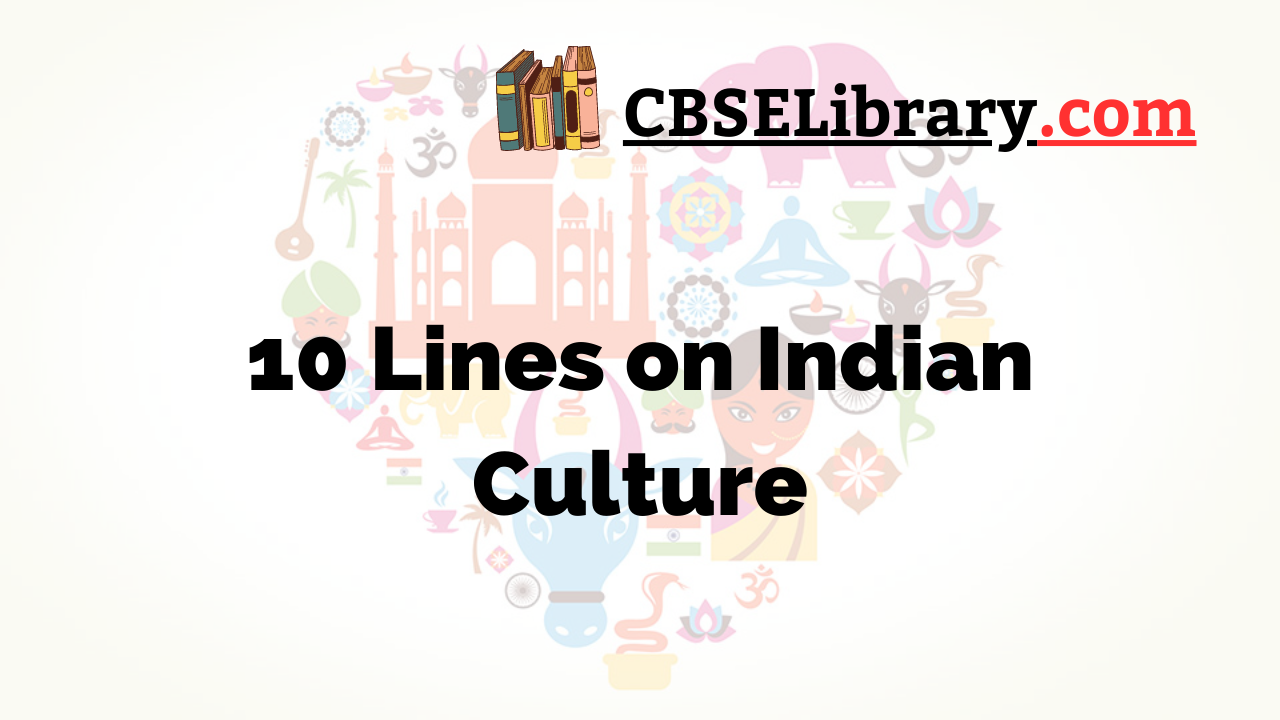10 Lines on Indian Culture:India is one of the countries of ancient time in the world. People, weather, and geographical conditions have deeply influenced Indian culture and tradition. It is believed that Indian culture is unique in the world. It is because India has diversity in many religions, castes, ethnicity, and race.
India is one of the countries in Asia. Also, India is the seventh-largest country in the world by area whereas India is the second-most populated country in the world. However, India is vast as far as its traditions and cultures are concerned.
India has its unique culture and traditions; thus, India is distinct from the whole world. In simple terms, India is a land that has a culture of cultures that no country of the world has. Even though there are many cultures and traditions in India, people live in love, affection, peace, and harmony that shows the unique culture of ‘Unity in Diversity’
We have provided 10 lines on Indian culture. After going through these sets, you can understand the speciality of India. Also, you can understand the different festivals that are celebrated in India. Moreover, there are many monuments, languages, etc. that make India unique.
You can read more 10 Lines about articles, events, people, sports, technology many more.
Set 1 – 10 Lines on Indian Culture for Kids
Set 1 is helpful for students of Classes 1, 2, 3, 4 and 5.
- India is the land of a different variety of religions and castes with its own features and attributes.
- Indians believe that they are fortunate to have rich traditions and culture.
- It is believed that Indian cultures are from ancient times.
- India has been deeply attached to its roots of the old cultures.
- The advancement in India can be seen in medicine, mathematics, science, technology, architecture, and many more.
- India is a huge combination having 29 states and seven union territories across all the four directions.
- India is the only country where Islam, Buddhism, Hinduism, Sikhism, Christianity and many other religions exist.
- Every religion in India has its own tradition and festival- for example, Holi, Diwali, Eid, guru Parav, Christmas, and many more.
- India is rich in traditional aspects by saying Namaste or Namaskar to greet anybody. Also, touching feet of elders is one of the Indian cultural in greetings.
- The food and eating habits of India changes from state to state in India. However, India has its own specific food style and eating style.

Set 2 – 10 Lines on Indian Culture for School Students
Set 2 is helpful for students of Classes 6, 7 and 8.
- The Charminar, The Taj Mahal, Qutub Minar, Varanasi Temple, Lotus Temple, Indian Gate, Akshardham, and many more reflect India’s glory and traditions.
- Many different castes, religions, cultures, and traditions reside in India.
- India is a country where people from different castes, traditions and religions live together in peace.
- Indian culture glory gets reflected in historical monuments like Charminar, Victoria Palace, Golden Temple, Qutub Minar, and many more.
- Also, Indian culture reflects in dance, art, medicine, yoga, music, and Ayurveda, etc.
- Indian cultures teach everyone to remain peace and kind.
- Our traditions and cultures are attached to the Indian’s lifestyle and behaviour. The decisions that Indians take are based on the cultures and traditions of India.
- There are 29 states in India. Each state has its own speciality, uniqueness, and languages. For example, Tamil, Hindi, Telugu, Kannada, Malayalam, and many more.
- India, with its rich traditions and cultures, attracts millions of tourists every year from all the parts of the world.
- India is the only place in the world where it is a cluster of cultures that cannot be found in any other country.
Set 3 – 10 Lines on Indian Culture for Higher Class Students
Set 3 is helpful for students of Classes 9, 10, 11, 12 and Competitive Exams.
- Indian cultures and traditions are popular all over the world.
- Various art forms, such as dance, paintings, and music, are also a part of India’s heritage.
- It is believed that India has preserved traditions and cultures for centuries.
- Indian cultures and traditions encourage everyone to remain peaceful, humble, and respect others in society.
- Indians are fortunate to have glorious and magnificent traditions and cultures.
- India’s monuments attract people from different parts of the world.
- Indians believe that it is their responsibility to invoke love and affection for Indian heritage in the younger and future generations.
- Indians believe in the philosophy of ‘Atithi Devo Bhava’. It means the guest will be equal to God; thus, he is welcomed with respect.
- The concept of the ‘Arranged Marriage’ system is practised in India. However, it is one of the countries where parents will choose a life partner for their children.
- Religions and castes in India have a significant impact on the traditions and cultures of India.

FAQ’s on 10 Lines on Indian Culture
Question 1.
What is the culture in India?
Answer:
- Indians speak different languages
- Dress differently from one state to other
- Follow different religions
- Eat different food
Question 2.
How can you teach Indian culture to someone?
Answer:
- Teach them about the Indian culture by explanations
- Narrate some stories of the past.
- Teach Indian values and morals
- Make them attend cultural programmes, festivals, and occasions
Question 3.
What is unique about Indian culture?
Answer:
India is a land that ‘Unity in Diversity’. Also, many different forms of dances are found in different parts of India. They are the best way of representation of the particular culture and tradition from which they originate.
Question 4.
What does Indian tradition and culture teach everyone?
Answer:
Indian tradition and cultures are the contiguous of honesty, truth, affection, respect and brotherhood with justice, right to human.
